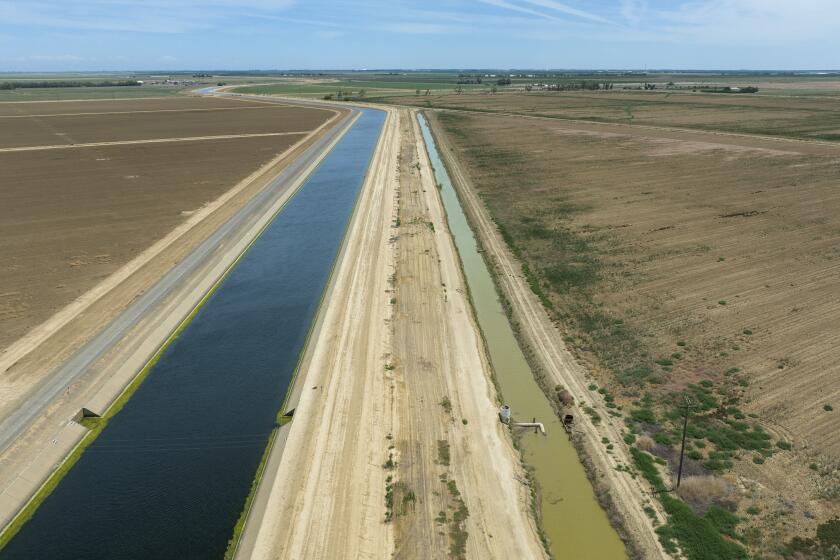Immigration made homeless numbers worse than they actually were in 2024

- Share via
A surge in immigration that peaked just as last year’s homeless count was taken accounted for the bulk of its historic rise reported in December, grossly inflating the picture of homelessness in America.
Because the local agencies taking the count across the country do not ask for immigration status, homeless numbers ballooned in a handful of states that took in tens of thousands of immigrants, and those states, in turn, pushed the national number to an unprecedented high of nearly 772,000.
In releasing the Annual Homelessness Assessment Report in the last few days of 2024, the U.S. Department of Housing and Urban Development cited immigration, along with the shortage of affordable housing and natural disasters, as a cause of the 18.2% increase nationally. But it did not provide an estimate of how much of the increase was from immigration.
In fact, more than three-fourths of the increase occurred in five states, among them California, that were prominent recipients of immigrants.
“Because they can’t disaggregate them and there is no attempt to try to figure out what the migrant population is, it’s creating a number that’s uninterpretable,” said Dennis P. Culhane, professor of social policy at the University of Pennsylvania and a leading national expert on homelessness.
A Times analysis based on methods Culhane devised to control for immigration shows that domestic homelessness probably increased by not much more than 7% nationally and that California’s modest increase could well have been lower than the 3.1% that HUD reported.
The failure to account for immigration also probably understated the 2.2% decrease the city of Los Angeles reported.
The inordinate influence of immigration suggests that year’s increase and, to a lesser extent, the 12% increase reported in 2023 are aberrations that will lead to a dramatic correction when this year’s count is taken this month.
Though immigrants stressed homeless systems, forcing cities such as New York and Chicago to spend millions of dollars to create new shelters, they were more likely than domestic homeless people to quickly find housing on their own. In November, ABC7 in New York reported that 1,400 immigrants were leaving shelters for every 600 arriving, and both cities have begun cutting back their capacity.
A truer picture of homelessness will emerge now that traffic across the Southern border has been down since last summer and tens of thousands of immigrants counted as homeless last January have left the homeless system on their own, Culhane said.
(Due to catastrophic wildfires, the Los Angeles Homeless Services Authority has announced a postponement of the January count until Feb. 18-20. The disaster will undoubtedly affect the count in unpredictable ways.)
The failure to separately account for immigration in the annual report diminishes its ability to illuminate long-range trends in homelessness.
“It totally messes up our trendline,” Culhane said.
The annual assessment, called the point-in-time count, is used to apportion federal dollars and provides a long-term measure of the state of homelessness in America.
But it’s an imperfect and chronically out-of-date process that takes almost a year to gather data collected across the country by local administrative agencies called Continuums of Care that each develops its own methodology. After making the counts in January, the agencies publish results through the year. For last year, HUD released the compiled numbers Dec. 27.
Among the count’s faults, its results are subject to statistical error and it doesn’t account well for people who live in and out of other people’s homes.
“As bad as the point-in-time count is, all the faults in it, what has been remarkable is how consistent it has been. It usually varies only by [1%] or 2% going up or down.”
Culhane is writing a paper in which he will strive to untangle the misinterpretations of the count arising from the flawed count. In the aftermath of the release, he said, advocates on all sides have used the numbers to spread alarm with some placing the blame totally on the housing crisis and others finding evidence that the system is failing.
The rhetoric overwhelms more subtle trends that Culhane is looking for. In his timeline, homelessness was trending down nationally from 2010 onward, even while it was increasing on the West Coast. By 2018, “the West Coast increases overtook the declines that were happening elsewhere” and drove the national numbers up again.
Although overall homelessness was still nominally up in California, chronic homelessness, long the driving force of the state’s increases, decreased slightly in California last year, but ticked up across the nation.
To estimate the influence of immigration, Culhane devised a crude methodology using the outsize increases in states known to have received large numbers of immigrants and the unusually large increases in Latino and family homelessness.
Latinos accounted for more than 60% of the increases in the five states and were as high as 70% in New York.
Just less than half the national increase occurred in New York City, which was deluged with immigrants in 2024, largely shipped there by Texas Gov. Greg Abbott. Combined with New York state, counts in Illinois, Massachusetts, Colorado and California recorded increases totaling slightly fewer than 90,000, or 76% of the increase nationally. Adding on more than 5,000 people rendered homeless by the wildfire on Maui, Hawaii, would account for 80% of the entire increase.
Not all those people would have been immigrants, but other factors would balance that out, Culhane said. Not all immigrants were Latinos, and much of the immigration was spread among other states. In its announcement, HUD said 13 communities reported being affected by immigration. HUD declined The Times’ request for the names of those communities.
Like Chicago, the city with the second highest influx of immigrants, New York created a separate shelter system for immigrants, providing it a way to infer the domestic trend.
In January 2024, when the count was taken, the city had 69,000 migrants in shelters, according to Mayor Eric Adams. That was more than the 54,819 that HUD reported as the growth in the city’s homeless population. Since then the number has declined markedly, and with nearly three times more immigrants now exiting the system than entering, the city is planning to start closing shelters.
Alone among American cities, Denver reported two numbers, one for HUD and a smaller number for its own audience, excluding those living in the separate system it created for immigrants. The 9,977 homeless people that the Metro Denver Homeless Initiative posted on its website was 30% less than the number it was required to report to HUD and represented an increase of only 77 people.
Kyla Moe, deputy director of MDHI, said the lesser number was calculated to maintain “data integrity and comparability.”
“The temporary migrant shelters were funded through a distinct funding stream, separate from the traditional sources used to support the homeless services system,” Moe said. “Including these temporary shelters in the local [point-in-time] reporting could introduce inconsistencies and potential distortions in the data, making it difficult to accurately assess and track long-term homelessness trends within the existing system.”
A similar adjustment could not be made in California or Los Angeles, however, because newly arriving immigrants — many bused from Texas — were simply absorbed into the existing system, in some cases causing shelters to overflow.
The immigrant bulge affected California less than the East Coast cities, but still clouds comparisons of state and local trends to the rest of the nation and may have muted gains the state has made.
After the release of the report, Gov. Gavin Newsom’s office issued a statement highlighting the state’s relatively low rate of increase, at 3.1%, compared with the national figure of 18.2%.
Subtracting immigrants from the count would make California look more like the rest of the country but still with less than half the rate of increase.
But the state’s own number would be lower. Latinos made up 36% of the state’s total increase of 5,685 reported to HUD.
Likewise, Los Angeles Mayor Karen Bass could have boasted more robustly that the city bucked the national trend if its modest estimated decrease of 1,008 homeless people had been adjusted for the hundreds of migrants who arrived downtown over the last two years.
After increasing incrementally for several years, Latinos spiked in the 2023 count. Then last year their numbers more or less leveled off, even as total homelessness was in decline.
More to Read
Sign up for Essential California
The most important California stories and recommendations in your inbox every morning.
You may occasionally receive promotional content from the Los Angeles Times.











